NRAO Newsletter
Volume Vol#, Issue Iss#
Day# Month# Year#
NRAO Newsletter
Volume Vol#, Issue Iss# • Day# Month# Year#
 W Aquilae (W Aql) is a binary system at a distance of 395 parsecs, studied with ALMA (Danilovich et al. 2024, Nature Astronomy, 8, 308).
W Aquilae (W Aql) is a binary system at a distance of 395 parsecs, studied with ALMA (Danilovich et al. 2024, Nature Astronomy, 8, 308).
Upcoming Events

Follow the Monarchs: A Journey to Explore the Cosmos at (Sub)milliarcsecond Scales with the ngVLA
Nov 11 - 14, 2024 | Morelia, Mexico
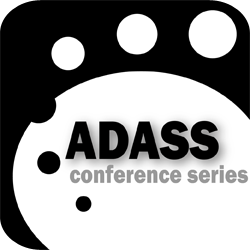
Astronomical Data Analysis Software and Systems XXXIV
November 9 - 14, 2024 | Valletta, Malta

245th American Astronomical Society Meeting
Jan 12 - 16, 2024 | National Harbor, Maryland
Volunteers Needed to Serve on VLA, GBT, & VLBA Science Review Panels

Image by Brian R. Kent, US NSF/AUI/NSF NRAO/NSF GBO
Members of NRAO's Science Review Panels (SRP) play a very important role in identifying the Science Programs for these world-leading radio telescopes. Being a reviewer could help you to:
- Learn what science other astronomers are interested in;
- Get a sense of what makes the most compelling proposals;
- Build your group of professional contacts and potential collaborators;
- Understand the review process for a major observatory.
If you are interested, please apply to be a volunteer SRP member!
Ken Kellermann delivers the 2024 Charlottesville NRAO Jansky Lecture

Dr. Ken Kellermann accepts the Jansky Lecture award, with members of Karl Jansky's family in attendance.
Dr. Kenneth Kellermann, Senior Scientist, Emeritus at the National Radio Astronomy Observatory delivered the 2024 Jansky Lecture, an honor established by the trustees of AUI to recognize and celebrate outstanding contributions to the advancement of radio astronomy.
After an introduction and presentation of the award by NRAO Director Tony Beasley, Ken shared the amazing history of the field of radio astronomy with the audience, including many members of Karl Jansky's family.
Ken is the co-author of Open Skies: The National Radio Astronomy Observatory and Its Impact on US Radio Astronomy with Ellen Bouton and Sierra Brandt. This open access book on the history of the National Radio Astronomy Observatory covers the scientific discoveries and technical innovations of late 20th century radio astronomy with particular attention to the people and institutions involved.
More recently his book with Ellen Bouton, Star Noise: Discovering the Radio Universe, tells the fascinating story of the remarkable, mostly accidental, or serendipitous discoveries in radio astronomy that have transformed our view of the Universe. Star Noise is about the men and women who made the discoveries, the circumstances that enabled them, and the unanticipated ways that scientific research really works.
The public lectures will take place on the following dates:
- Charlottesville on Thursday, October 24, 2024. A recording of the lecture is available.
- Green Bank on Wednesday, November 6, 2024. The lecture will take place in the Science Center auditorium starting at 7PM ET followed by a light reception with the Green Bank staff.
- Socorro on Friday, November 22, 2024. The lecture will start at 7PM MST at the Macey Center followed by a reception.
Very Large Array Sky Survey - Completion and Next Steps
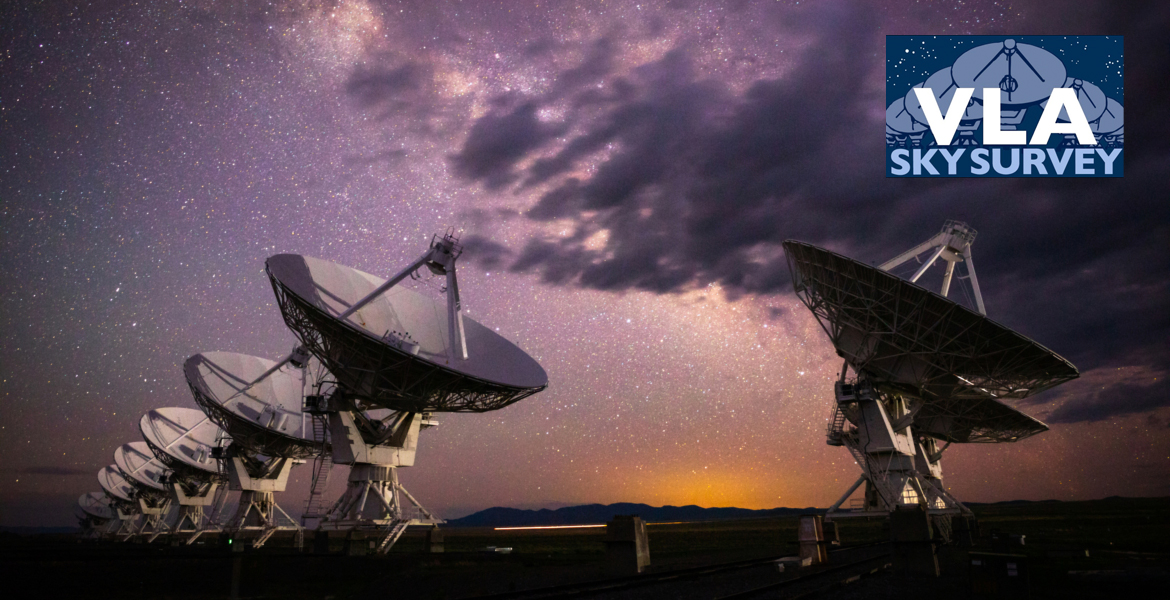
Image by Bettymaya Foott, US NSF/AUI/NSF NRAO
Recently, the NRAO successfully completed a seven-year sensitive radio survey of the sky using the VLA. This data set (the Very Large Array Sky Survey - VLASS) was conducted over three epochs, and produced a data set already being used extensively for studying radio source morphologies and polarizations, and the detection of new radio sources and transient phenomena. The VLASS team is now pivoting to complete the high-level data products from the survey over the next three years, and to support the growing community using VLASS for astronomical research.
An international panel was convened virtually in September 2024 to explore the operational and scientific impacts of further VLASS observing. Following their recommendations, NRAO has decided to re-observe the first section of sky explored in the survey to enhance the VLASS survey data sensitivity and transient detection opportunities. This final epoch of observing (4.1) will begin in late 2025. Future large surveys with the VLA, for example in conjunction with the Rubin Telescope and/or other future facilities, will be considered in coming years.
From planning and scheduling observations to processing and delivering data, VLASS has pushed the boundaries of our engineering, computing, and scientific capabilities. The Observatory would like to extend our thanks to everyone who dedicated their time and effort over the past decade to make this groundbreaking survey possible. While the initial observations for VLASS are nearing completion, much work remains to deliver the final high-level data products. With the commitment, tools, and talent across the observatory, the NRAO will provide these products and support future scientific discoveries.
CASA 6.6.1-17 with Pipeline 2024.1.0.8 Released for VLA Data Processing

Figure: VLA D-configuration data (15A-089) in X-band toward the massive star forming region W49. The peak intensity map of the spectral window containing the H108 beta, H86 alpha, and He 86 alpha recombination lines is shown in the image and the spectrum is extracted toward the G-sources. The data were calibrated, continuum-subtracted, and imaged automatically with the VLA pipeline. Courtesy of De Pree, C.; Wilner, D.; Tobin, J. Click to enlarge.
The CASA and NRAO pipeline teams have released a new version of the VLA calibration and imaging pipeline (2024.1.0.8), running on CASA 6.6.1-17. This version is now installed on NRAO systems and can be downloaded by users. This version of CASA and the pipeline are identical to what is used for ALMA data processing, thus users can process data for both telescopes with the same package. Data processing at NRAO with the new pipeline began at the start of the VLA A-configuration, during mid-October 2024.
The primary new features of the pipeline that are specific to the VLA are:
- Spectral line processing is now properly supported by the pipeline. Several tasks have been modified to enable more automated spectral line processing, the pipeline webpage contains more detail on which and how tasks were modified.
- Spectral line processing requires the pipeline to know what spectral windows are to be used for spectral lines, as such the pipeline can only automatically detect the windows that are more narrow than the default continuum setups as having a spectral line intent. Spectral line projects using the default continuum setups will need to either designate all spectral windows as spectral line or manually specify those windows.
- Beginning in D-configuration (February 2025), spectral line imaging will begin to be run at the NRAO by the pipeline operations team.
- Antenna position corrections are only added for updates that occurred within 150 days of observations.
- Flux density bootstrapping was updated to better support cases with high and low fractional bandwidth. The fractional bandwidth threshold to use a 4th order fit was lowered to 1.5 (dnu/nu) and regardless of band, if a spectral setup spans less than 256 MHz, a 0th order fit is used.
- The use of the wproject gridder for L and S-band imaging has been disabled due to high memory requirements.
- Several bugs in the hif_selfcal task have been fixed to make target self-calibration more robust.
- TEC data will now appear again in pipeline runs for data taken after August 7, 2023.
A more detailed description of the VLA Calibration pipeline is available, as is a description of the VLA Imaging pipeline. More information about automated self-calibration is available. See also the ALMA pipeline documentation for general, non-VLA-specific infrastructure changes.
ALMA Program News
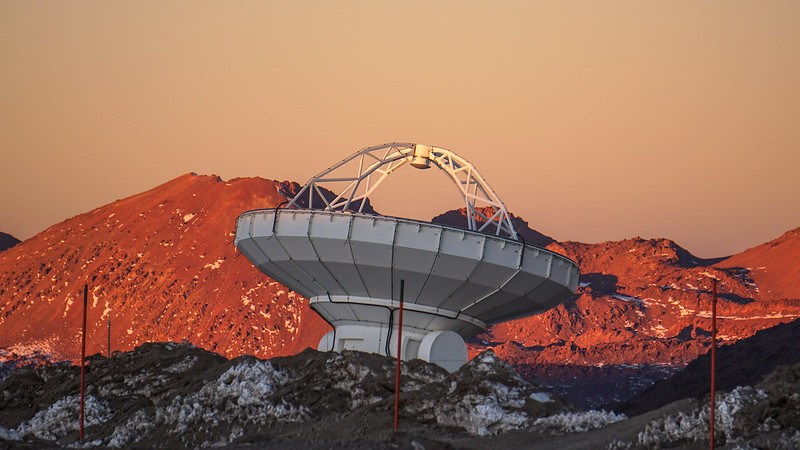
Image Credit - Pablo Carrillo (ALMA)
ALMA Observing Status
Cycle 11 began on schedule at the start of October. A total of 245 high-priority proposals (Grades A and B) were scheduled from the total of 1712 proposals which were submitted. These scheduled proposals account for 4107 hours on the 12-m Array, 2204 hours on the 7-m Array, and 2203 hours on the Total Power Array. This included four Large Programs recommended by the APRC. The highest priority Cycle 11 projects are listed at this link.
ALMA Cycle 10 Broke Observing Records
The ALMA Observatory announced that an impressive total of 4250 hours of science-quality data (QA0 PASS observations) were successfully acquired on the 12-m Array during Cycle 10, significantly exceeding the previous record of 3787 hours acquired during Cycle 5! Moreover, record numbers of hours were also achieved on the 7-m (3769 hours) and Total Power (2723 hours) arrays.
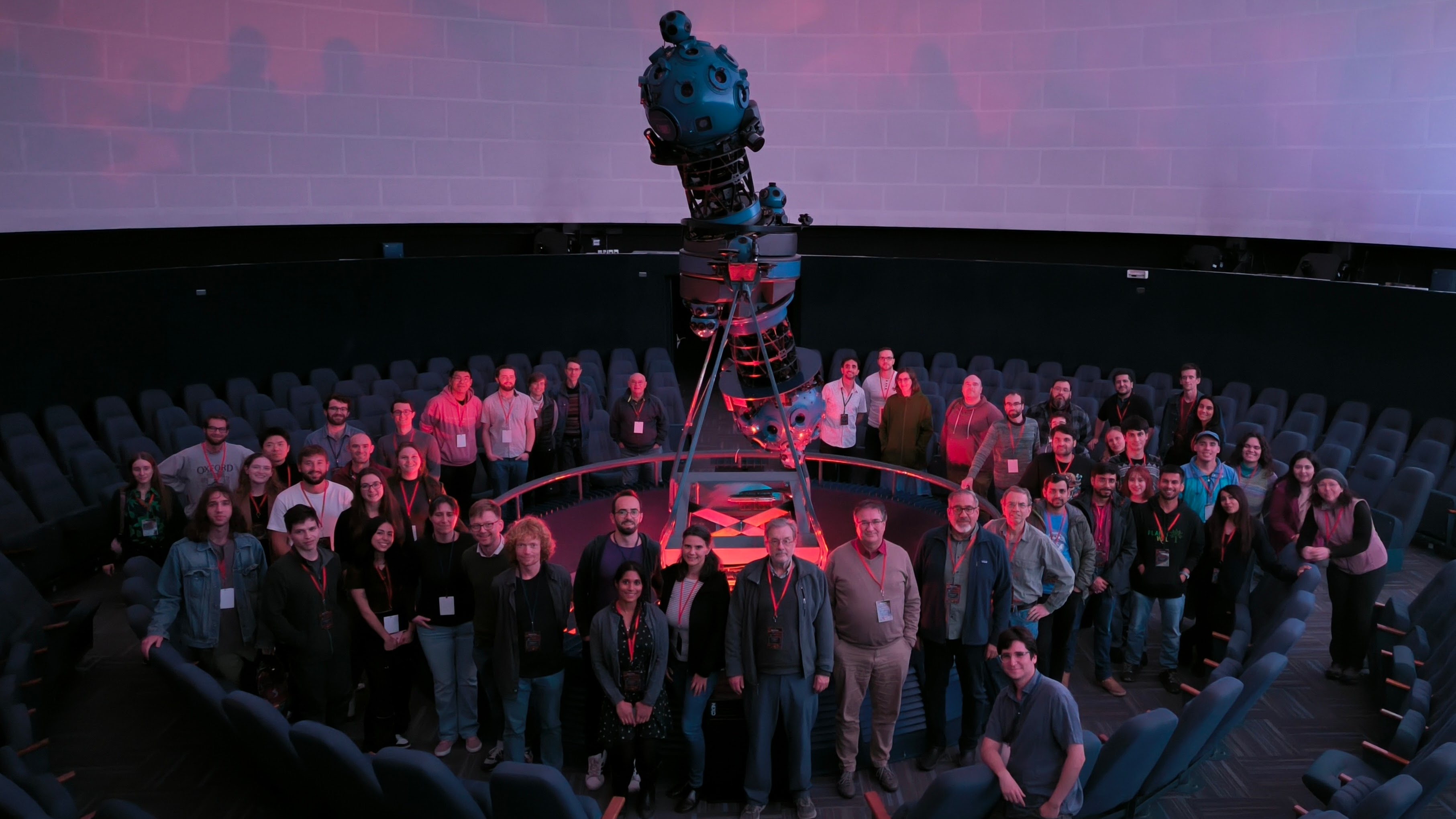
Born in Fire: Eruptive Stars and Planet Formation
(Photo left: Attendees at the Born in Fire conference assemble for an evening at Santiago's National Planetarium)
Born in Fire: Eruptive Stars and Planet Formation Conference brought together over 100 scientists from the planet formation and eruptive star communities for four days of dynamic discussions in Santiago, Chile. The conference was marked by healthy and constructive discussions across a wide range of career stages, a touch of Chileanity for atmosphere, and the birth of several new collaborations. Many attendees praised the smooth operation of the hybrid format by the host Universidad Diego Portales and the welcoming atmosphere provided by the YEMS Millennium Nucleus. With funding from NRAO via NAASC, registration fees were waived for over 30 students and early career researchers, enabling their participation and making the event more inclusive and enriching. (Courtesy of S. Perez)

ALMA Special Session at AAS 245, National Harbor, Maryland
A special session "New perspectives on protoplanetary disks in the era of ALMA-WSU and JWST" will present recent high-impact ALMA and JWST results in different subfields of protoplanetary disk studies. It will introduce how future synergistic experiments enabled by the transformative increase in capabilities which ALMA-WSU Wideband Sensitivity Upgrade will bring, spearheading the next revolution in the field. The session will include four invited talks by M. Van't Hoff (Purdue University), C. Espaillat (Boston University), K. Pontoppidan (JPL), K. Zhang (Wisconsin) and a short general presentation of the WSU. The session is scheduled to occur on Tuesday January 14th, from 10-11:30 am.
ALMA Wideband Sensitivity Upgrade (WSU) News
To support the increase in system bandwidth yielded by the Wideband Sensitivity upgrade, ALMA's data transmission rate requirement will need to be increased ten-fold, but cannot be accommodated by the current system. The new Data Transmission System (DTS) will be based on digital coherent optical transmission, as opposed to the amplitude modulation transmission used in the current system. Amongst other additional improvements, the new system will be able to send data with very low error rates over distances up to 80 km. The DTS underwent and passed its Preliminary Design Review on Oct 2-4 at NAOJ in Mitaka (Tokyo), and so the DTS project is now moving to the critical design phase.
Enabling New VLBI Science with the ALMA Phasing System - Phase 3 (APP3) Project Report
Starting in 2012 a series of ALMA North America Development projects led by the Massachusetts Institute of Technology (MIT) Haystack Observatory helped to enable the introduction of very long baseline interferometry (VLBI) capabilities at ALMA, the world's most sensitive millimeter/submillimeter observatory. This project has now resulted in the introduction of flexible tuning for ALMA very long baseline interferometry (VLBI) operations, a fully flexible spectral line VLBI observing mode, and the enabling of panchromatic VLBI, allowing ALMA in principle to operate as a phased array in any available receiver band. The project also carried out a series of activities aimed at maintaining and optimizing existing VLBI infrastructure and provided training to staff at the Joint ALMA Observatory (JAO) to enable a transition to autonomous VLBI observing. A video feature and accompanying news article were produced near the conclusion of this project to make the results accessible to a broader audience.
ALMA Cycle 11 Data Processing Workshops
The Cycle 11 ALMA Ambassador - led ALMA data processing workshops conclude over the next month. Events will train attendees in techniques for imaging ALMA data, analyzing images and cubes with CARTA, or the latest updates to CASA and the ALMA Pipeline! See the Community Events page or the table below for information on the remaining workshops.
| Ambassador | Workshop Location | Date |
|---|---|---|
| Joshua Lovell | Harvard-Smithsonian Center for Astrophysics | October 29, 2024 |
| Yu-Hsuan (Eltha) Teng | University of Maryland | October 29, 2024 |
| Olivia Cooper | University of Texas, Austin | November 22, 2024 |
ngVLA Project News
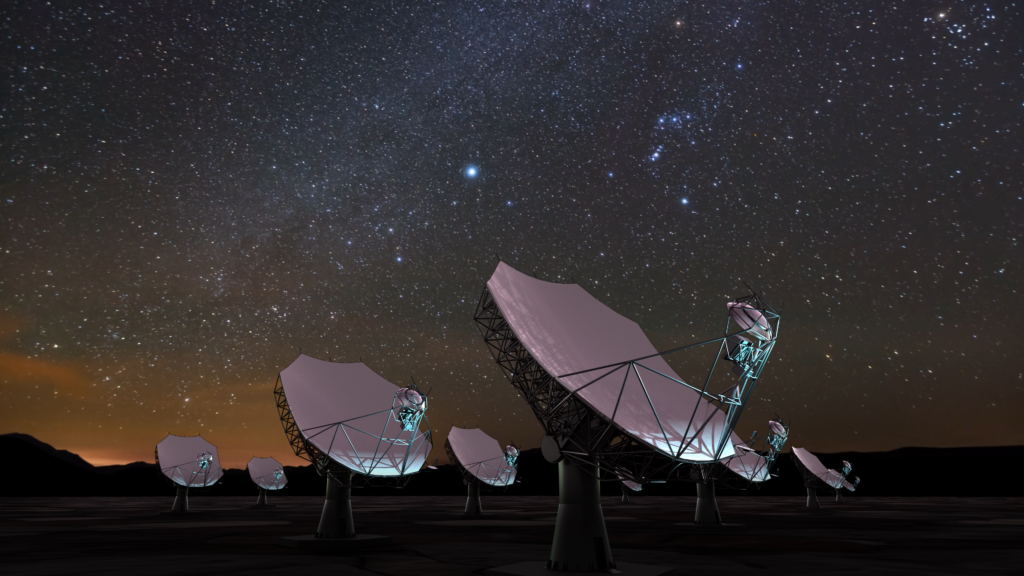
Graphic by Sophia Dagnello, US NSF/AUI/NSF NRAO
Join Us at the AAS Winter Meeting!
The NRAO and the ngVLA project are pleased to invite all AAS 245 attendees to these splinter sessions:
- The Next-Generation VLA: Update and Community Forum, AAS Session 183, Tuesday, January 14, 2:00 - 3:30 PM ET
- Exploring the Radio Sky with the DSA-2000 and the ngVLA, AAS Session 216, Wednesday, January 15, 9:30 - 11:00 AM ET
- Fundamental Physics and New Messengers, AAS Session 194 , Wednesday, January 15, 2:00 - 3:30 PM ET
The sessions' locations, speakers, and talk titles can be found here.
ngVLA Science - Radio Studies of Exoplanet Systems
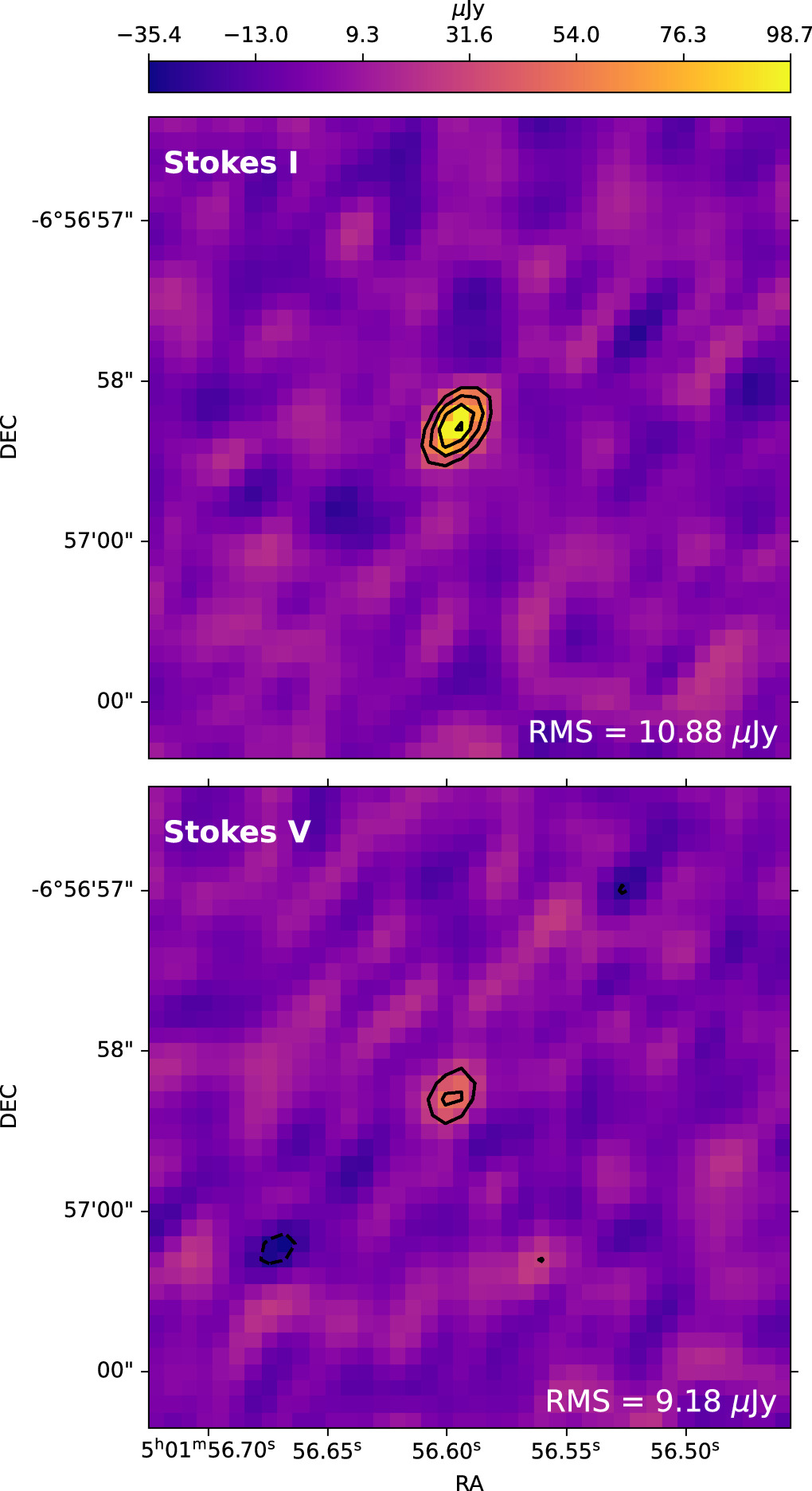
Figure: VLA detection at 6 GHz of GJ 3323, which hosts two close-in exoplanets. Credit: Ortiz Ceballos et al. (2024)
In our Solar System, we can use radio telescopes to directly measure the magnetic fields of the planets by studying the auroral radio emission that they produce. These measurements trace the structure and interior of planets, as well as interactions they may have with their moons. For exoplanets, understanding and measuring their magnetic fields is especially useful as a metric of their habitability and ability to retain an atmosphere.
Direct auroral emission from exoplanets may be too faint to detect with current radio telescopes, but planets close enough to their stars can interact with them in such a way as to modulate the stellar radio emission. An equivalent effect is already seen in the Solar System, with the orbit of Io modulating the radio emission from the aurorae of Jupiter (Zarka 2007). A recent VLA detection of short bursts from the star YZ Ceti (Pineda & Villadsen 2023) suggests that we may already be seeing this phenomenon in at least one nearby system. These bursts were found to be nearly coincident with the orbital period of the star's innermost planet, suggesting that the emission may be caused by star-planet interaction.
Recently, we used the VLA at 6 GHz to conduct the largest survey to date of star-planet systems. We examined 77 nearby stars hosting 140 exoplanets. For 76 systems, we set luminosity upper limits comparable to detections of brown dwarfs. We detected one system, GJ 3323, an M4 dwarf just 5 parsecs away (see figure). Our observation of it was too short to look for YZ-Ceti-like bursts. Still, only a small handful of stars with known exoplanets have been detected at GHz frequencies, and our survey adds another valuable target for follow-up with the VLA and later the ngVLA.
The principal limitation to radio studies of exoplanet systems is that the processes that produce emission in planets or star-planet interactions are generally too faint to be detected by current telescopes, except for the very closest stars. The advent of the ngVLA will significantly improve our reach in terms of sensitivity, opening up many more systems for study. This will allow us to go further out in distance and expand our sample size for sensitive observations.
Since 2015 the acronym ngVLA has appeared in 1200+ publications indexed in the SAO/NASA Astrophysics Data System. This article continues a regular feature intended to showcase some of those publications. We are especially interested in showcasing work done by early-career researchers. The collection of showcase articles can be viewed online. Anyone wishing to volunteer to author a feature should contact Joan Wrobel.
Dr. Joseph Silk Speaks on the Future of Cosmology at the Joint NRAO/UVa Colloquium
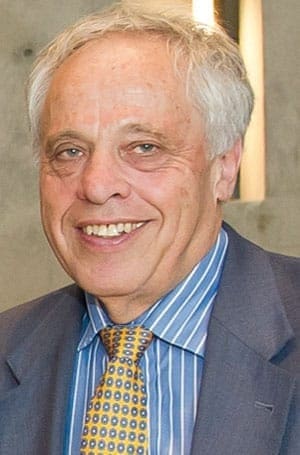
On Thursday, 19 September, 2024, the National Radio Astronomy Observatory (NRAO) and the University of Virginia Department of Astronomy invited Dr. Joseph Silk - Research Professor and Homewood Professor of Physics and Astronomy at Johns Hopkins University to give an online colloquium. He studied at Cambridge, earned his PhD from Harvard in 1968, was a postdoctoral fellow at Cambridge and Princeton, and taught at the University of California, Berkeley, and the University of Oxford. He joined Johns Hopkins in 2010. The topic of the colloquium was: The Future of Cosmology.
The Joint NRAO/UVa colloquium hosted more than 200 online participants in addition to the over 30 participants in the NRAO Headquarters Auditorium. NRAO and UVa host a weekly colloquium series, (nearly) every Thursday at 11AM ET. The Joint NRAO/UVa colloquia schedule is available online. We invite the scientific community to attend the Joint NRAO/UVa colloquia virtually by signing up for the colloquium announcement email list.
In the presentation, Dr. Silk highlighted the remarkable advances in precision cosmology since the groundbreaking ideas proposed by Lemaitre a century ago. However, we now face a pivotal moment. With experiments becoming increasingly large and costly, we must carefully prioritize the next steps to achieve compelling and guaranteed scientific breakthroughs that push beyond the current limits of cosmology.
The lunar surface offers a unique path forward. The far side of the Moon provides a radio-quiet environment ideal for exploring the Universe's ultimate frontier: the dark ages, through 21 cm interferometry. This approach may also reveal elusive insights into the nature of cosmic inflation. Additionally, the permanently cold and dark polar craters could host far-infrared telescopes capable of using the cosmic microwave background spectrum to investigate our cosmic origins during the Universe's first months.
Optical and infrared interferometers, operating at unprecedented resolution and sensitivity, would tackle profound questions about distant galaxies, massive black holes, and the search for biological markers in the atmospheres of exoplanets - raising the ultimate question: Are we alone in the Universe?
Dr. Silk's presentation is available online, and sign up through the colloquium mailing list to receive future emails on upcoming talks.
NRDZ Partnership and Workshop Series
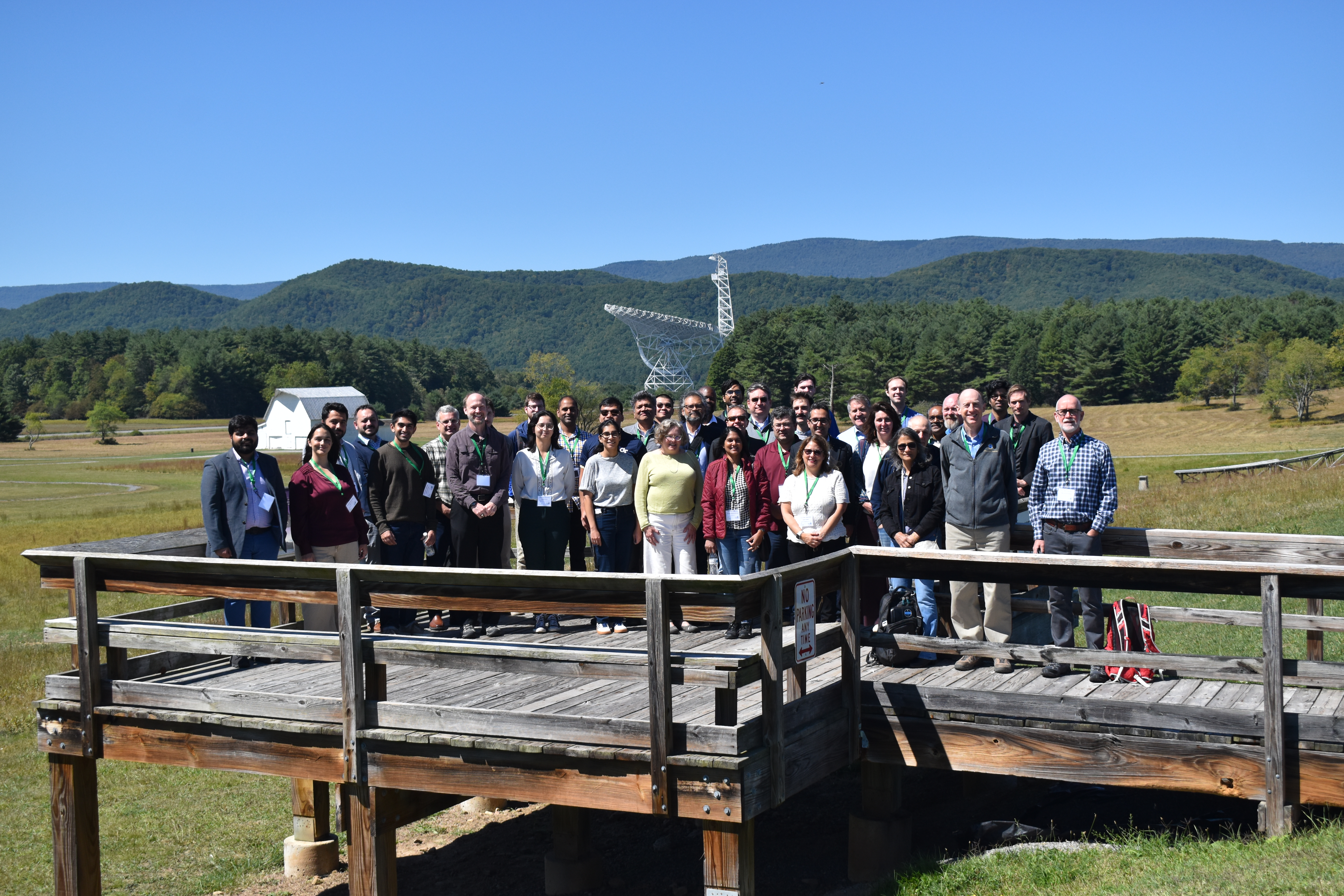
This capstone event of the NSF-supported NRDZ Partnership and Workshop Series was held in-person at the historic Green Bank Observatory in the heart of West Virginia. It is also within the United States National Radio Quiet Zone, where policy-making and technology come together to ensure interference-free astronomical observations. The goal of this event was to continue to conceptualize the NRDZ as a nation-scale testbed for spectrum coexistence research, while immersing in the instrumentation and capabilities of one of the key spectrum stakeholders - the scientific users.
The workshop featured a comprehensive, high-quality technical program, including a variety of keynotes, panels, discussion sessions, and technology demonstrations from prominent spectrum researchers. The workshop was designed as a forum to foster connections, collaborations, and translating research results into applications. Participants explored new and creative mechanisms aimed at enabling spectrum coexistence, thus unlocking the potential of next-generation wireless technologies while ensuring access for scientific and sensing systems.
The workshop emphasized:
- Spectrum sensing, management, and decision techniques for passive-active sharing.
- Spectrum resource allocation and sharing models.
- Coexistence techniques, including between active/passive satellite/terrestrial systems.
- Experimental zones, especially NRDZ experimental facilities and national DSS testbed.
- RFI management, mitigation, and coordination approaches for radio astronomy and remote sensing.
- Spectrum, propagation, and interference measurements and models.
Recent Science Media Releases
|
A Cosmic Chemical Breakthrough
|
|
|
Massive Stars Born from Violent Cosmic Collapse
|
|
|
AI Meets the Cosmos: Astronomers' Ambitious Plan to Tackle Astronomical Big Data
|
|
|
Astronomy based on Earth - and Space - Will Give Astronomers More Powerful Tools
|
|
|
ALMA Observes More Than Ever Before
|
|
|
Ken Kellermann Awarded the 2024 Karl G. Jansky Lectureship |
|
|
Contact the NRAO press office to share your new and exciting science results. |
From the Archives
Ellen Bouton
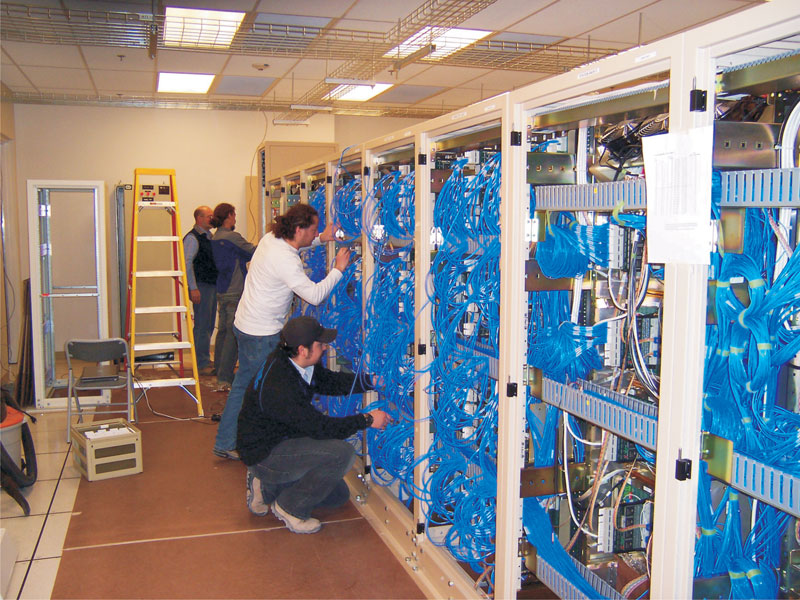
About this month's photo: In October 2008, the first quadrant of the ALMA bilateral correlator, which could serve 16 antenna stations, was being wired for duty at the AOS Technical Building at the 16,500 foot site. Thirteen hundred cables were installed and tested in the oxygenated correlator room of the building; automated software detected two interchanged cables, which were quickly corrected. In Charlottesville, testing was ongoing on the correlator's second quadrant, which was installed in 2009 and could serve 32 antenna stations, and the third quadrant was being assembled. Left to right in this photo: Lorenzo Martinez-Conde, Rodrigo Araya, Alejandro Saez, Sebastian Argandoña. Thanks to Alejandro Saez for help with caption information.
From the Archives is an ongoing series illustrating NRAO and U.S. radio astronomy history via images selected from our collections of individuals' and institutional papers. If readers have images they believe would be of interest to the Archives, please contact Ellen Bouton.


